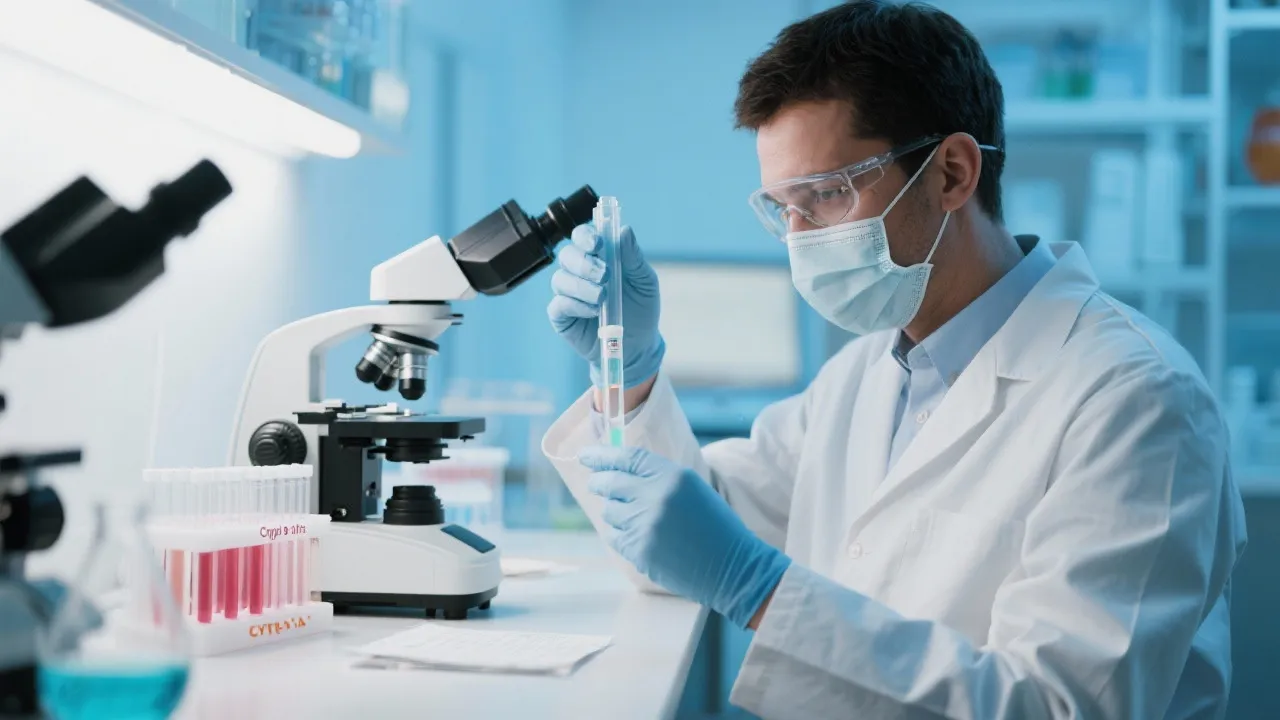Understanding the Cyp1a1 Assay Process
The Cyp1a1 assay is a crucial method in molecular biology for evaluating enzyme activity related to drug metabolism. Central to pharmacogenomics research, this assay helps predict individual responses to various pharmaceutical compounds. With its focus on the enzyme's role in metabolizing polycyclic aromatic hydrocarbons and other compounds, it aids both research and therapeutic applications.

Introduction to Cyp1a1 Assay
The Cyp1a1 assay is an essential tool in the field of pharmacogenomics, enabling scientists to measure the activity of the cytochrome P450 1A1 enzyme. This enzyme is highly significant because it is involved in the metabolism of drugs and xenobiotics. By understanding its function through the assay, researchers can predict how individuals will respond to different therapeutic agents, making it a vital component of personalized medicine. The ability to tailor medical treatments based on the metabolic capabilities significantly enhances therapeutic efficacy while minimizing adverse drug reactions. Moreover, the relevance of the Cyp1a1 assay extends beyond human healthcare, influencing the fields of environmental science, toxicology, and pharmacology.
The Role of Cytochrome P450 1A1
Cytochrome P450 1A1 (Cyp1a1) belongs to the broader cytochrome P450 family of enzymes, which are responsible for the oxidation of organic substances. Cyp1a1, in particular, is known for its role in the bioactivation of polycyclic aromatic hydrocarbons (PAHs), which are substantial environmental pollutants. It also participates in the metabolic pathways of various drugs, emphasizing its importance in detoxification processes. Given that many pharmaceuticals are designed to be metabolized by specific enzymes, the activity of Cyp1a1 can dictate not only the therapeutic effects of these drugs but also their potential toxicity during metabolism. Because of these roles, Cyp1a1 assay results can provide valuable insights into environmental toxicity and the pharmacokinetics of new drugs.
Conducting a Cyp1a1 Assay: A Step-by-Step Guide
To effectively conduct a Cyp1a1 assay, one must follow a series of carefully structured steps. Each step is critical for ensuring the accuracy and reliability of the results:
- Sample Preparation: Begin by preparing tissue samples or cultured cells where Cyp1a1 is expressed. These samples need to be homogenized to allow enzyme extraction. The quality and type of sample play a crucial role in the assay’s sensitivity and specificity. For example, liver tissues are commonly used due to their high expression levels of Cyp1a1.
- Substrate Selection: Choose an appropriate substrate that the Cyp1a1 enzyme will metabolize. Common substrates include ethoxyresorufin, which converts to resorufin—a measurable fluorescent compound. Substrate concentration and purity can significantly affect the outcome of the assay, thus requiring careful consideration.
- Incubation: Incubate the samples with the substrate under controlled conditions, allowing the enzyme activity to occur. Factors such as incubation time, temperature, and buffer conditions need to be optimized to ensure maximal enzyme activity. Furthermore, pH plays an essential role in enzyme function, influencing both the rate of reaction and the stability of the substrate and product.
- Detection: Measure the product formation via fluorescence or colorimetric methods, quantifying enzyme activity based on standard curves. It is crucial to run a blank to correct for background fluorescence. Maintaining the integrity of the detection method is paramount to avoiding false positives or negatives.
- Analysis: Compare the results against controls to determine the activity level and effect of potential inhibitors or inducers on Cyp1a1 activity. Statistical analysis of the data is also necessary to ensure the reliability of the results and to address any variability introduced during the experimentation.
Conditions and Requirements for Accurate Assay Results
Ensuring the reliability and accuracy of the Cyp1a1 assay involves meeting several specific conditions:
- Temperature Control: Assays should be conducted at optimal temperatures (typically 37°C) to maintain enzyme stability. Deviations from this can alter enzyme kinetics and result in skewed data.
- Substrate Concentration: Use of precisely calibrated substrate concentrations is critical for consistent readings. It is essential to conduct preliminary experiments to determine the Km value of the enzyme with respect to the chosen substrate to ensure accurate interpretation of the kinetics.
- Instrumentation: High-quality fluorescence or spectrophotometric equipment is essential to detect and record minute changes in reactant concentration. Maintaining calibration of instruments ensures that measurements are both precise and accurate, mitigating systematic errors.
- Quality Reagents: Employing high-purity reagents minimizes potential assay interferences and ensures reproducibility. It is advisable to confirm the integrity and activity of the reagents prior to use, as degraded or contaminated materials can compromise the results.
Importance of Cyp1a1 Assay in Research and Medicine
This assay serves both academic and industrial purposes. In research, it assists in understanding enzyme regulation, pollutant processing, and interindividual variability in drug metabolism. The ability of Cyp1a1 to metabolize various xenobiotics and therapeutic agents allows scientists to explore genetic polymorphisms that contribute to differences in drug response among individuals.
Its application extends to drug development, where assessing CYP1A1 activity can identify potential drug-drug interactions, ultimately contributing to safer therapeutics. The Cyp1a1 assay is particularly valuable when screening new compounds for their metabolic pathways. If a new drug is metabolized by Cyp1a1, its interaction with PAHs should also be considered during the pharmaceutical design phase, as the presence of these environmental contaminants can influence drug efficacy and safety. Furthermore, this assay plays a critical role in toxicology, where monitoring Cyp1a1 activity can help determine the effects of environmental pollutants and their potential health implications.
Comparison Table: Different Cyp1a1 Assay Techniques
| Technique | Description | Advantages | Disadvantages |
|---|---|---|---|
| Fluorescence Assay | Measures product formation using fluorescent substrates. | High sensitivity; real-time measurement of enzyme activity, allowing the observation of rapid kinetics. | Requires expensive equipment and expertise in fluorescence spectroscopy. |
| HPLC-Based | Separates products using high-performance liquid chromatography. | High accuracy; detailed metabolite profiling possible, essential for understanding multiple pathways. | Time-consuming; requires technical expertise and extensive sample preparation. |
| Spectrophotometric | Detects changes in absorbance related to product formation. | Simple; accessible to many laboratories with basic spectrophotometric equipment. | Lower sensitivity and specificity compared to methods like fluorescence or HPLC. |
FAQs
- What is the main application of the Cyp1a1 assay? The Cyp1a1 assay is primarily used to evaluate the metabolic activity of the Cyp1a1 enzyme concerning drugs and xenobiotics, providing insight into how these substances are processed in the body.
- How does Cytochrome P450 1A1 relate to drug metabolism? Cyp1a1 is involved in the oxidation of various pharmaceutical compounds, influencing their bioavailability and efficacy. Its role in bioactivation can also lead to the formation of reactive metabolites, which may contribute to drug toxicity.
- Why is substrate selection important in a Cyp1a1 assay? The substrate determines the sensitivity and specificity of the assay, and choosing the correct one is essential for reliable results. The selection of substrates can also influence the apparent kinetic parameters and the interpretation of metabolic pathways.
- Can these assays be used to test environmental toxins? Yes, they are often employed to study the bioactivation of PAHs and other environmental pollutants, making them invaluable in toxicology studies. This can provide insights into how environmental exposures influence human health and contribute to disease.
Current Trends in Cyp1a1 Research
As the understanding of cytochrome P450 enzymes like Cyp1a1 continues to grow, several trends are emerging in research that emphasizes its importance across various fields:
- Personalized Medicine: The exploration of genetic variations in Cyp1a1 is crucial for understanding interindividual differences in drug metabolism. Pharmacogenetic studies aim to identify polymorphisms that can influence drug metabolism rates, enabling more tailored and effective treatment plans.
- Environmental Health: Researchers are investigating the impact of Cyp1a1 activity on how individuals metabolize environmental toxins. Given the increasing concerns regarding pollution and its influence on health, this research is vital for developing strategies to mitigate toxic exposures.
- Drug Development: Pharmaceutical companies are increasingly integrating Cyp1a1 assays into their drug screening processes. Understanding the metabolism of candidate drugs through Cyp1a1 helps predict their safety profiles and potential interactions with other drugs.
- Platform Technologies: Advances in high-throughput screening techniques enable researchers to conduct Cyp1a1 assays more efficiently. Automation and novel assay formats are making it feasible to evaluate a larger number of compounds simultaneously, enhancing the drug discovery process.
Future Directions and Challenges
Despite the significant advancements made in understanding Cyp1a1 and its functions, several challenges and future directions warrant attention:
- Understanding Mechanisms: While the activity of Cyp1a1 has been well established, the underlying molecular mechanisms must still be fully understood. Research aimed at elucidating how various substrates and inhibitors interact with the enzyme can lead to better therapeutic outcomes.
- Translational Research: Bridging the gap between laboratory findings and real-world clinical applications remains a challenge. Further studies should focus on integrating assays into clinical practice, particularly in monitoring patients on medications metabolized by Cyp1a1.
- Exploring Alternative Substrates: The identification of novel substrates for Cyp1a1 may uncover new therapeutic applications and improve the accuracy of current assays. This requires a multidisciplinary approach combining pharmacology, biochemistry, and molecular biology.
- Environmental Impact of Cyp1a1: The investigation of climate change and urbanization effects on the expression and regulation of Cyp1a1 presents a vital area for future research. Understanding how environmental factors affect enzyme activity can lead to better risk assessments regarding health impacts from pollution.
Conclusion
The Cyp1a1 assay remains a pivotal element in the toolkit of researchers focused on drug metabolism and toxicology. Its ability to predict metabolic responses not only advances personalized medicine but also fortifies our understanding of environmental impacts on health. Through precise methodology and innovative applications, the assay continues to be an indispensable asset in biomedical research. Furthermore, as future research addresses the burgeoning challenges and explores new frontiers, the importance and utility of the Cyp1a1 assay are expected to proliferate, paving the way toward novel therapeutic strategies and improved health outcomes for diverse populations.





